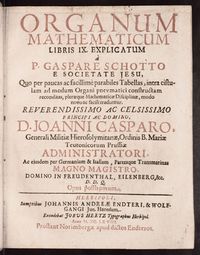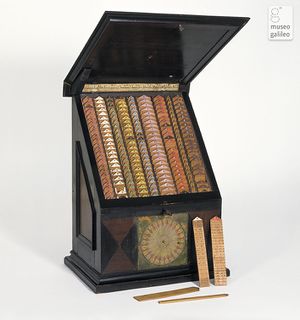Athanasius Kircher’s Organum mathematicum. On the Evolutionary Improbability of an Information Processing Innovation
For the last few years, the Historical Archives of the Pontifical Gregorian University (APUG) has been conducting, with the generous support of Fondazione Sorgente Group, a research project on the figure and encyclopedic work of the German Jesuit Athanasius Kircher.[1] The project involves the digitalization of Kircher’s works, the digitalization and controlled transcription of his letters,[2] and the collaborative compilation of a universal bibliography on the life, the works and the historical and cultural context in which Athanasius Kircher has lived. This research project focuses specifically on the invention of the Organum mathematicum.
Recently, it has been observed that “much literature has been published on Athanasius Kircher, but far too little on his Organum mathematicum”.[3] Actually, Kircher’s bibliography, which is currently available on GATE, seems to confirm that impression. Out of more than 600 bibliographic references (references are continuously expanding), those expressly devoted to the Organum are just half a dozen (1%).
This suggests an opportunity to devote more attention to the Organum. The intention would be to organize a case study around this scientific tool in order to finally shed light on the historical and cultural context surrounding Kircher’s invention and, at the same time, to explain the evolutionary improbability of a machine designed to make calculations, such as that envisaged by the German Jesuit.
| Organum mathematicum |
|---|
Research Project
The purpose of this project is to offer a comprehensive collection of contributions specifically devoted to Athanasius Kircher’s Organum mathematicum (approximately 1661).
- The issue is, first, to clarify the historical and cultural context surrounding Kircher’s invention. Indeed, it is known that, starting from the middle of the 16th century, technique experienced a sort of ‘rehabilitation’ in the context of the profound change concerning knowledge, with the gradual decline of relevance of the classical distinction between liberal and illiberal arts. Already in late 16th century, a surprising number of catalogues (or ‘theaters’) of machines has been published,[4] even though those machines were still conceived as ‘hobbies’, as ingenious and surprising objects mostly designed with the aim to impress the audience. In conclusion, technique was still mainly conceived as “technica curiosa”.[5] The hypothesis is that curiosity might serve primarily as a temporary support to justify something that, at least in the first phase of transition towards full modernity, was still considered as being highly unlikely in the eyes of contemporaries. Therefore, Kircher’s invention comes from a century of profound social and cultural transformations which have at least facilitated, if not suggested, the idea of developing a calculating machine such as the Organum mathematicum. This context shall be investigated carefully.
- Of all the machines of knowledge, calculating machines are certainly those that have most attracted the attention of philosophers, mathematicians and engineers between the 16th and the 17th century, so much so that at the beginning of the 18th century, it was perfectly possible to write a story of such technology, thus presenting the state of the art concerning calculators.[6] Often, at the base of such inventions, there were Napier’s tables. The same Organum ingeniously employs those tables when operating with the mathematical chest (cistula).[7] The calculation thus turned into a combinatorial activity which could be carried out following carefully the instructions contained in the machine itself. Actually, the machine was operated by a manual algorithm (i.e. an ordered set of instructions to be executed in a predetermined and non-reversible temporal succession). What the user learned, when becoming acquainted with the algorithm, was not mathematics, but only how to use the machine. So, it is untrue that the Organum was designed as a “teaching tool”.[8] Like any technique in general, the Organum allowed the user to perform any computations properly without knowing why the computations were correct.
- More generally, the Organum may legitimately be included among the many machines[9] through which, from the 17th century onwards, knowledge has come to be reproduced by means of the interaction between user and machine. The main hypothesis of this research project is that precisely this unprecedented interaction constitutes the most obvious improbability of the Organum. Instead of training the conscience to reproduce knowledge, the user is training the machine to correctly answer his questions whenever the user has information needs to be satisfied. Evolution makes probable that improbability, thus gradually transforming it into an obviousness. In this sense, the Organum can be regarded as a “precursor of the computer.”[10] The question is what socio-cultural conditions this evolutionary progress implied and what has made it plausible the idea of a “memory without records” as is Kircher’s calculating machine.
- The project might ultimately be an opportunity to perform an investigation on Kircher’s letters, limited to the years before and immediately after the conception and implementation of the Organum (approximately 1650-1670).[11] It is a question of verifying, through the study of the correspondence, whether, with whom and in what terms Kircher has been discussing his idea to implement a calculating machine. It is plausible to believe that the Organum has encountered quite a resonance within his correspondence, also taking into account the importance Kircher attributed to this tool for creating a dense network of personal contacts and intensifying the intellectual activity.
Publication
The research project is aimed at the publication of a collection of contributions in English specifically devoted to the Organum mathematicum. The book will be edited by a committee chaired by Prof. Martín Morales and composed by Dr. Irene Pedretti, Dr. Lorenzo Mancini and Prof. Alberto Cevolini. The book will contain about 15 scientific articles. The publication may include an iconographic section aimed at showing the external form, the internal structure and the functioning of the Organum mathematicum.
This publication, which is the first at international level specifically devoted to the Organum, shall include the contributions of scholars coming from various disciplines (historians of science, historians of mathematics, archivists, sociologists of science), whose purpose is illustrating not only the functioning of the individual parts of which Kircher’s machine is composed, but also the historical, social and cultural background surrounding his invention. Researchers involved in this project will be selected by invitation or through a call-for-papers.
The publication might also include the translation of the important article by Mara Miniati, Les cistae mathematichae et l’organization des connaissances au XVIIe siècle, one of the rare contributions to the study of Kircher’s Organum (never appeared, either in Italian or in English), or the translation of the article by Hans-Joachim Vollrath, Das Organum mathematicum - Athanasius Kirchers Lehrmaschine (which also never appeared, either in English or in Italian).
References
- ↑ The project, entitled Athanasius Kircher, a Case Study, is part of a wider digitalization project called GATE (Gregorian Archives Texts Editing). The portal is open to the collaboration of scholars who wish to make a contribution to the transcription, edition and annotation of documents stored in the archive. See this page for more information.
- ↑ The vast collection of Kircher’s letters is entirely preserved in the APUG and consists of 14 volumes of letters still largely unexplored.
- ↑ Franz Daxecker, Der Jesuit Athanasius Kircher und sein Organum mathematicum. «Gesnerus. Swiss Journal of the History of Medicine and Sciences», 57(1-2), 2000, pp. 77-83 (83).
- ↑ For instance, Jacob Besson, Il Theatro de gl’Instrumenti & Machine. In Lyon: For Bartholomeo Vincenti, 1582; Agostino Ramelli, Le diverse et artificiose machine. Paris: In the author's house, 1588; Faust Vrančić, Machinae novae, Venetiis: s.e., in 1595 (the catalogue includes, in addition to the usual mills and world time watches, even the parachute).
- ↑ Kaspar Schott S.J., Technica curiosa, sive mirabilia artis libri XII comprehensa. 2 vols., Herbipoli: Sumptibus Johannis Andreae Endteri & Wolfgangi Junioris Haeredum, 1664.
- ↑ See Jean Marguin, Histoire des instruments et machines à calculer. Trois siècles de mécanique pensante 1642-1942. Paris: Hermann, 1994. For a history of technological development especially dedicated to calculating machines, see Jacob Leupold, Theatrum arithmetico-geometricum, Das ist: Schau-Platz der Rechen- und Meß-Kunst. Leipzig: Christoph Zunkel, 1727, especially chaps. VII-XI.
- ↑ To use the mathematical chest, that is, the ‘calculator’ contained within the Organum, first of all it was necessary to remove the table of applications and read the instructions. If the calculation the user intended to perform was a multiplication, it was necessary to extract all the strips that reported on the tip the number corresponding to the digits to be combined. For example, 3, 6 and 0, if the multiplication to be carried out was 7 × 360. At this point, the user had to put the table of applications alongside the three rulers extracted, thus verifying the figures that appeared in the areas corresponding to the seventh: the numbers located on the same diagonal would be added, from right to left, in order to get the result of the multiplication. See Gaspar Schott, S.J., Organum Mathematicum libris IX explicatum. Herbipoli: Sumptibus Johannis Andreae Endteri & Wolfgangi Junioris Haeredum, 1668, vol. 1, in part. pp. 70-72.
- ↑ As stated by Hans-Joachim Vollrath, Das Organum mathematicum. Ein Lehrmittel des Barock. «Journal für Mathematik-Didaktik», 24, 2003, pp. 41-58.
- ↑ Think also of the wooden filing cabinet consisting of mobile entries sorted in alphabetical order, which was invented by Thomas Harrison at the beginning of the 1640s. See Thomas Harrison, The Ark of Studies. Turnhout: Brepols, 2017.
- ↑ On this, there are conflicting opinions. Contra Franz Daxecker, Der Jesuit Athanasius Kircher und sein Organum mathematicum, cit., p. 83; pro Hans-Joachim Vollrath, Das Organum mathematicum” cit., p. 56.
- ↑ In a letter dated 7 June 1655 (APUG 561: 37r-37v), Kircher’s pupil, Kaspar Schott, refers to the master to have seen in Wurzburg an exemplary of the arca Musurgica that Kircher himself had left there together with another ark containing “bacillis rabdologicis”, namely napierian rulers used to perform mathematical calculations. It seems consequently that the cista mathematica physically existed already in the mid-1650s. See the transcription of the letter in Hans-Joachim Vollrath/Thomas E. Conlon (eds.), Kaspar Schott an Athanasius Kircher. Briefe 1650-1664. Wurzburg: Königshausen & Neumann, 2016, p. 40ff.


